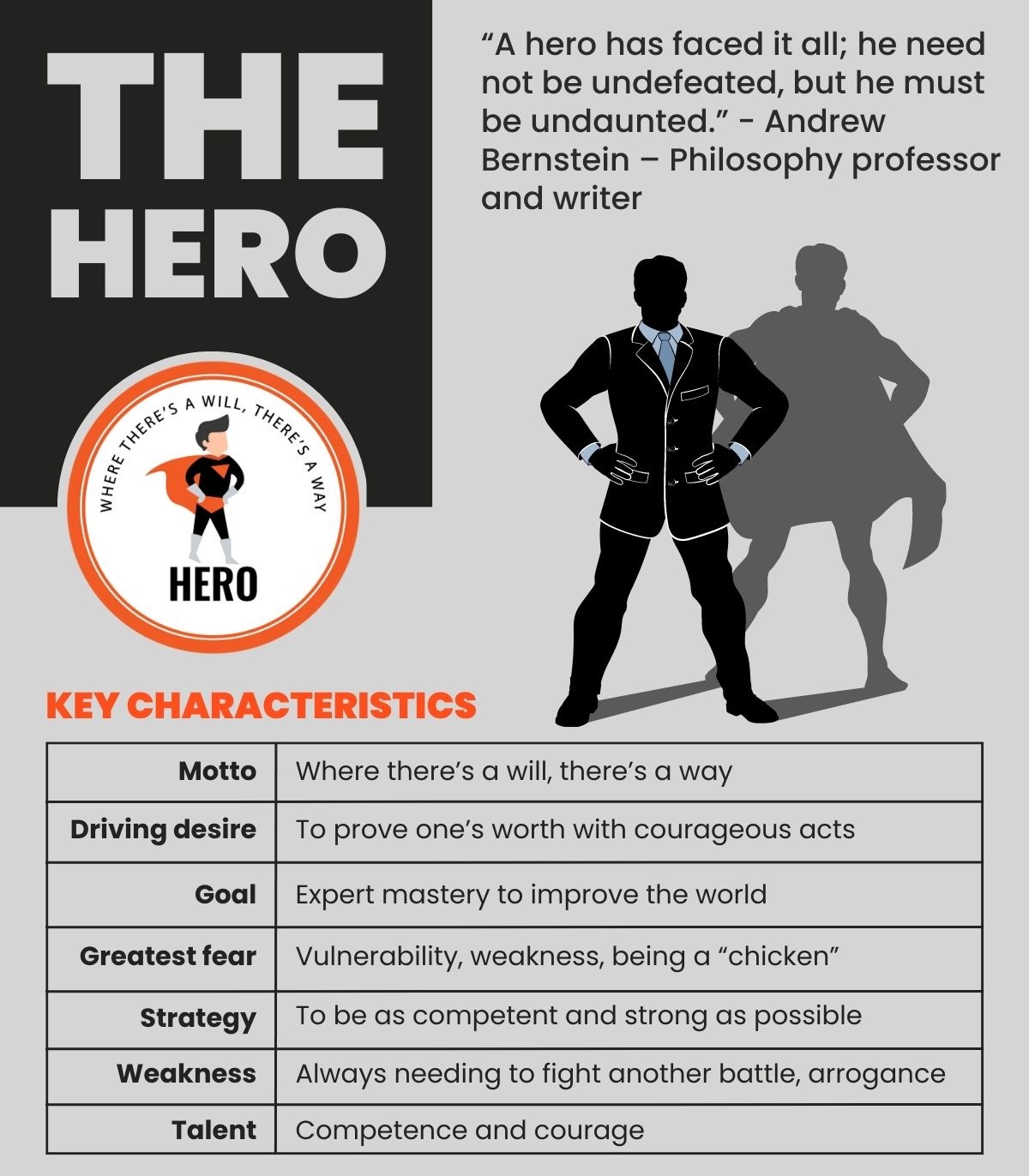Table of Contents
“A hero has faced it all; he need not be undefeated, but he must be undaunted.” – Andrew Bernstein – Philosophy professor and writer[1]
Introduction
The Hero represents the brand that inspires others to do better. Through great victories, powerful words, or monumental sacrifices, the Hero enacts change. The Hero is easily distinguishable from the crowd in society, as they often wear a uniform to display their status.
Also known as a warrior, crusader, rescuer, soldier, superhero, and winner.[2]
Key Characteristics
- Motto: Where there’s a will, there’s a way
- Driving desire:To prove one’s worth with courageous acts
- Goal: Expert mastery to improve the world
- Greatest fear: Vulnerability, weakness, being a “chicken”
- Strategy: To be as competent and strong as possible
- Weakness: Always needing to fight another battle, arrogance
- Talent: Competence and courage
Description of the Hero
The Hero is a leader, bravely forging forward, making a path for their followers. In business, those with strong social obligations often utilize the Hero archetype in their marketing to guide others to develop different types of strength and discipline. Heroes have almost always overcome great adversity to get to where they are. Hero brands aim to guide their customers on the same path they took, helping them reach greater heights than they could on their own. Marketing often has bold, catchy phrases combined with inspirational clips of people performing at their peak. Hero brands dare their customer to reach the same heights.
The Hero archetype has three levels to it. The first level is the process of becoming a Hero. This process means facing significant challenges and overcoming an unusual amount of adversity. Ideally, the Hero needs to succeed, though failure can be as great a teacher as any. The second level comes with success. The Hero has saved others or inspired them to become better in some way. The Hero has developed an ironclad sense of duty and is entirely devoted to their cause. In the third level, the Hero’s sense of self-sacrifice and humble servitude has grown. They put the greater good over their good, truly becoming a hero.
Perhaps the most well-known example of a Hero brand is Nike. In Greek mythology, Nike is the goddess of victory. And that is precisely what the brand Nike markets. Their commercials show great successes. Not only success, but they also show the hard work and sacrifice it takes to get there. Their advertisements are often inspiring, pushing people to become better versions of themselves, just like a Hero would. The Hero archetype is most evident in Nike’s popular slogan “Just Do It.”
- Brand Motivations
- Mastery
- Success
- Protection
- Development
- Defense
- Courageousness
- Growth
- Brand Challenges
- Cowardice
- Downfall
- Incapability
- Deterioration
- Limited
- Incompetence
- Failure
- Brand Strategy
- Overcoming challenges and obstacles
- Becoming the best version of yourself
- Proving doubters wrong
The Hero in the Wild
The following companies, organizations, and industries are good examples of the Hero.
- Archetype Examples: Nike, Red Cross, Marines, FedEx, Gold’s Gym, Marvel, Jordan Brand, Gatorade
- Industries: Industry examples: Sportswear, sports equipment, outdoor and tactical equipment, trade services, comic books
Conclusion
The Hero brand is an ideal that people strive for in life. It is the goal far in the distance that makes people want to be better. A Hero should be inspiring. They should always try to live up to the ideals people have placed upon them, for the moment they do not, they cease to be a Hero.
[1] https://www.idlehearts.com/222606/a-hero-has-faced-it-all-he-need-not-be-undefeated-but-he-must-be-undaunted
[2] “Branding 101: 12 Brand Archetypes”, (n.d.), Retrieved from: https://marketingideas101.com/featured/branding-101-12-brand-archetypes/


